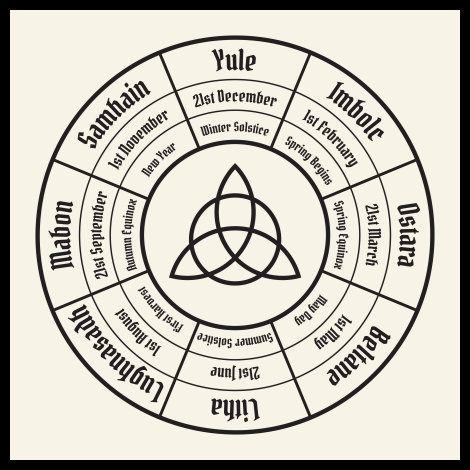
The Wheel of the Year*
Samhain…Yule…Imbolc…Ostara…Beltane…Litha…Lughnasadh…Mabon…
For Pagans today, these names conjuring up exotic images of ritual and celebration roll off of the tongue as easily as they did for our ancestors.
Together, the eight Sabbats constitute the cornerstones of the circular calendar we know as the Wheel of the Year.
Most Pagans tend to think of four distinct seasons, each containing two Sabbats, when they think of the Wheel of the Year and for Pagans living in temperate climates this is primarily true, but we have to remember that the seasonal holidays vary depending on where you live.
If you live in Australia it makes no sense to celebrate Litha (Midsummer) in June because at that time Australia lies in the grip of winter.
Hawai’i’s seasonal changes are so subtle that cyclic changes are completely different than those of more temperate regions.
So the first thing to understand about the Wheel of the Year is that you should adapt your holidays to match the environment in which you live.
The celebrations our coven follows are based on the four-season model because we live in the Pacific Northwest, where we experience all four seasons.
The Sabbats & Tradition
There are debates raging over whether the Celts celebrated the equinoxes and solstices. There are differing views on what each Sabbat represents. Ask twenty Pagans to define the nature of Litha and you’ll get twenty answers. We have discovered that the concept of the coven was probably created by the Inquisition in order to implicate more people in the Witch Trials.
Quite frankly, while this is all very fascinating, it doesn’t really matter to us. We cannot turn back time. While it is important to understand the roots of our traditions, we must acknowledge that we can never know for sure just what our ancestors were thinking or doing. We take the remnants of the past and work with them to create a meaningful present.
We must remember that we are celebrating the Wheel of the Year as we see it today. We have reconstructed it from information gleaned from the past.
And so…
- The Corn God still dies at Lughnasadh because we still harvest the corn for food…
- We remember our ancestors at Samhain because death is never still and it is vital to remember the past, the good as well as the bad…
- By the same token, though I (Yasmine) am pledged to Finnish deities, I don’t live in Finland, nor am I of Finnish blood and I’m not going to wear seven scarves on my head to keep my power from leaking out! (An old Finnish tradition among female shamans). Nor are my ritual clothes blue and red, traditional Finnish colors. But I will celebrate Kalevala Day (a relatively new tradition).
Which of our rites and rituals actually date back to the days when Pagans held sway over the planet? It is difficult to say. Our concepts and our essential connection with the land, of course. Some of our terminology, definitely. But our religion, though grounded in the past, is based in the present.
It evolves as we evolve, and so we can be sure it will thrive.
Rites of Birth, Death & Love
The Wheel of the Year as we celebrate it here comprises the seasonal changes that surround us.
Personalized Tradition for Solitary and Group Use
Each person seeking to formulate a path for themselves needs to remember that the key to successfully turning the Wheel (i.e. celebrating each Sabbat in turn) is found by discovering the connection between the holiday and one’s self.
As you develop your spiritual path, each year you hone and refine your observances, cutting closer and closer to the core. Remember what works and build on those moments. Throw out what doesn’t. The whole concept of personalized ritual and celebration rests squarely on being true to your spiritual path and if a celebration doesn’t feel right, then it won’t bring meaning into your life.
When and/if you celebrate with others, your group must be able to blend energies, to make the ritual work for everyone. Which is why with most large public rituals, there tends to be a sense of ritual theatre more than of deep magic. This is not to say that the ritual won’t be fun and sometimes I’ve been pleasantly surprised, but for stronger, more magickal rituals, we opt for coven work.
*This information comes from Dancing With the Sun by Yasmine Galenorn
Copyright 1999 and 2020, Yasmine Galenorn
All rights reserved. You are NOT free to post this on other sites, via email, etc.
